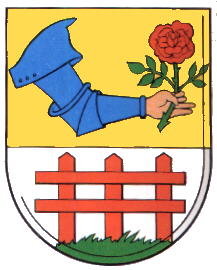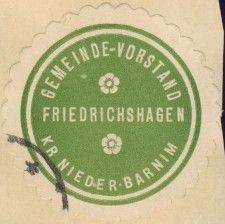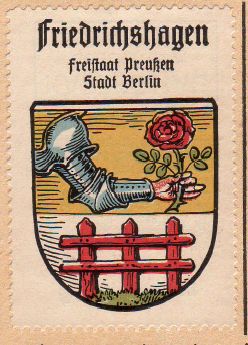Friedrichshagen (Berlin): Difference between revisions
Knorrepoes (talk | contribs) m (Text replacement - "{{media1}}" to "{{media}}") |
Knorrepoes (talk | contribs) m (Text replacement - "|Wappen von {{PAGENAME}}]]" to "|Wappen von {{PAGENAME}}/Coat of arms (crest) of {{PAGENAME}}]]") |
||
| Line 27: | Line 27: | ||
{|align="center" | {|align="center" | ||
|align="center"|[[File:friedrichshagenz1.jpg|center]] <br/>Seal of the city from around 1900 | |align="center"|[[File:friedrichshagenz1.jpg|center]] <br/>Seal of the city from around 1900 | ||
|align="center"|[[File:b-friedrichshagen.hagd.jpg|center|Wappen von {{PAGENAME}}]] <br/>The arms by [[Otto Hupp|Hupp]] in the [[Kaffee Hag albums]] +/- 1925 | |align="center"|[[File:b-friedrichshagen.hagd.jpg|center|Wappen von {{PAGENAME}}/Coat of arms (crest) of {{PAGENAME}}]] <br/>The arms by [[Otto Hupp|Hupp]] in the [[Kaffee Hag albums]] +/- 1925 | ||
|} | |} | ||
Revision as of 10:59, 20 August 2023
FRIEDRICHSHAGEN
State : Berlin
Incorporated into : 1920 Berlin
| German | blazon wanted |
| English | blazon wanted |
Origin/meaning
Friedrichshagen was founded in 1753 and the oldest known seal of the village dates from 1808. The seal already showed a shield with the same composition as the above arms, an arm holding a rose in the upper part and a fence in the lower half. The arm probably symbolises King Friedrich II, founder of the village.
The flower is a mulberry flower. Friedrichshagen was a village known for the silk manufacturing and spinning.
The fence in the lower half, is a canting element for Hagen (Gehege). The fences were built to protect the village from the wild animals, especially wild boar.
| Seal of the city from around 1900 |
The arms by Hupp in the Kaffee Hag albums +/- 1925 |
This page is part of the German heraldry portal Deutsche Wappensammlung |
Heraldry of the World |
|
German heraldry:
|
Selected collector's items from Germany:
|
Contact and Support
Partners:
Your logo here ?
Contact us
© since 1995, Heraldry of the World, Ralf Hartemink 
Index of the site
Literature: Machatscheck, 1987














